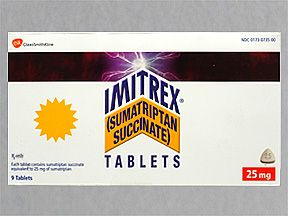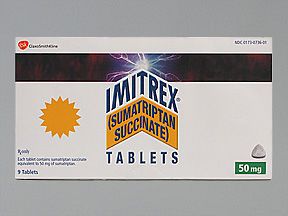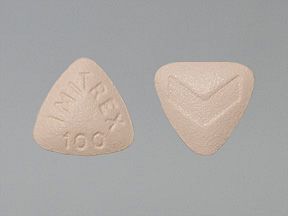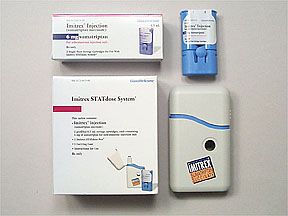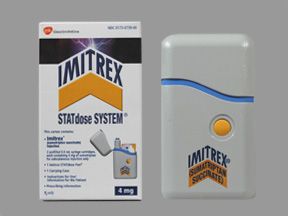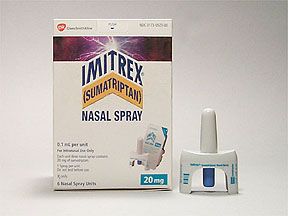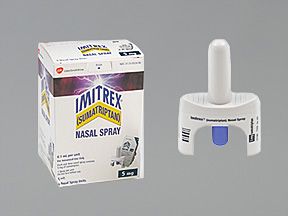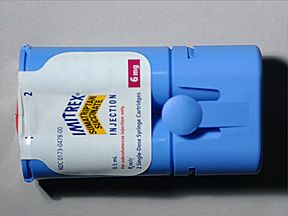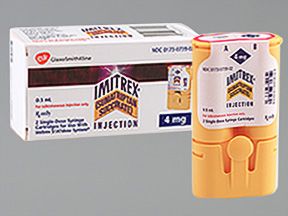Imitrex is a brand-name drug that’s prescribed for migraine. The medication is available as a tablet and an injection. Imitrex belongs to the triptan drug class.
Imitrex is approved by the Food and Drug Administration (FDA) to treat migraine episodes with or without aura. The injection form of Imitrex is also approved to treat cluster headaches.
Imitrex is approved for use in adults who have received a diagnosis of these conditions from a doctor. It isn’t used to prevent either migraine episodes or cluster headaches.
For more information about these uses of Imitrex, see the “Imitrex uses” section below.
Drug details
You’ll find key information about Imitrex below.
- Drug class: serotonin agonists, more commonly known as triptans
- Drug forms:
- oral tablet
- prefilled syringe cartridge, for use with an autoinjector pen to administer as a subcutaneous injection
- Generic available? yes
- Prescription required? yes
- Controlled substance? no
- Year of FDA approval: 1992
Imitrex can cause mild or serious side effects. The following lists contain some of the key side effects that may occur while taking Imitrex. These lists don’t include all possible side effects.
For more information on the possible side effects of Imitrex, see this article. You can also talk with your doctor or pharmacist. They can give you tips on how to deal with any side effects that may be bothersome.
Note: The Food and Drug Administration (FDA) tracks side effects of drugs it has approved. If you would like to report to the FDA a side effect you’ve had with Imitrex, you can do so through MedWatch.
Mild side effects
Mild side effects of Imitrex can include:*
- dizziness
- feeling weak
- feeling unusually warm or cold
- tingling or numbness in your fingers or toes
- vomiting
- injection site reactions, such as pain, stinging, redness or discoloration, and swelling (with the injection form)
- pain, pressure, or tightness in your chest, throat, neck, or jaw
- sleepiness†
- nausea†‡
Most of these side effects go away within a few hours or days. But if they become more severe or don’t go away, talk with your doctor or pharmacist.
* This is a partial list of mild side effects from Imitrex. To learn about other mild side effects, talk with your doctor or pharmacist, or see the prescribing information for the form of Imitrex you’re taking: Imitrex tablet or Imitrex injection.
† For more information on these side effects, see “Side effect details” below.
‡ Note that this side effect was reported in clinical trials of Imitrex nasal spray, which is discontinued.
Serious side effects
Serious side effects from Imitrex aren’t common, but they can occur. Call your doctor right away if you have serious side effects. Call 911 or your local emergency phone number if your symptoms feel life threatening or if you think you’re having a medical emergency.
Note that the serious side effects listed below were not reported in clinical trials of Imitrex tablet and Imitrex injection. But they were reported either after Imitrex became available to prescribe or as side effects of similar drugs called triptans.
Serious side effects of Imitrex and their symptoms may include:
- Serious heart problems, such as heart attack. Symptoms can include:
- severe pain, pressure, or tightness in your chest, arm, throat, neck, or jaw
- shortness of breath
- nausea or vomiting
- dizziness
- cold sweat
- Irregular heartbeat. Symptoms can include:
- feeling that your heart is pounding, racing, or skipping a beat
- chest pain
- dizziness
- fainting
- Stroke or bleeding in the brain. Symptoms may vary but can include:
- drooping on one side of the face
- sudden weakness or numbness on one side of the body
- slurred speech or trouble speaking
- severe headache that occurs suddenly
- Problems with blood circulation, such as Raynaud phenomenon (lack of blood flow to your nose, ears, fingers, or toes). Symptoms may vary but can include:
- fingers and toes that are white, blue, purple, or paler than usual
- numb fingers and toes
- cramping or pain in your legs
- weakness, tingling, or numbness in your legs
- Reduced blood flow to your stomach or intestines. Symptoms can include:
- sudden or severe abdominal pain
- bloody diarrhea
- constipation
- nausea or vomiting
- fever
- weight loss
- Serotonin syndrome (a dangerous condition caused by high levels of serotonin in your body). Symptoms can include:
- fast heartbeat
- sweating
- tight muscles
- loss of coordination
- feeling agitated or restless
- hallucinations (seeing or hearing things that aren’t really there)
- Very high blood pressure. Symptoms can include:
- severe headache
- chest pain
- confusion
- blurred vision
- shortness of breath
- Seizures. Symptoms can include:
- muscle spasms
- drooling
- sudden, rapid eye movements
- loss of bowel or bladder control
- loss of consciousness (not being able to respond to sound or touch)
- Allergic reaction.*
- Medication overuse headache,* also called a rebound headache.
* For more information on these side effects, see “Side effect details” below.
Side effect details
You may wonder how often certain side effects occur with Imitrex. Here’s some detail on several of the side effects this drug may cause.
Allergic reaction
As with most drugs, some people can have an allergic reaction after taking Imitrex. It is unknown how often this occurs. Symptoms of a mild allergic reaction can include:
- skin rash
- itchiness
- flushing
A more severe allergic reaction is rare but possible. Symptoms of a severe allergic reaction can include:
- swelling under your skin, typically in your eyelids, lips, hands, or feet
- swelling of your tongue, mouth, or throat
- trouble breathing
The needle shields on Imitrex prefilled syringe cartridges (for use with an autoinjector pen) contain a form of latex. If you have an allergy to latex, your doctor may recommend Imitrex tablets for migraine treatment or a medication other than Imitrex for your condition.
Call your doctor right away if you have a severe allergic reaction to Imitrex. Call 911 or your local emergency phone number if your symptoms feel life threatening or if you think you’re having a medical emergency.
Feeling sleepy
Taking Imitrex can make some people feel sleepy. This side effect was reported in clinical studies of the Imitrex injection.
It is unknown how often sleepiness occurs with the Imitrex tablets.
Along with sleepiness, Imitrex can also cause weakness and dizziness in some people. These side effects, as well as the migraine episode or cluster headache itself, can make it dangerous to drive or operate machinery. If you have these side effects, avoid driving and using machinery until you feel recovered enough to do so safely.
If you’re concerned about feeling sleepy while taking Imitrex, talk with your doctor.
Weight loss
Weight loss isn’t a direct side effect of Imitrex. However, it can be a symptom of reduced blood flow to your stomach or intestines, which is a serious side effect of Imitrex. It is unknown how often this side effect occurs with Imitrex.
Besides weight loss, other symptoms of reduced blood flow to your stomach or intestine can include:
- sudden or severe abdominal pain
- bloody diarrhea
- constipation
- nausea or vomiting
- fever
See your doctor right away if you have unexplained weight loss or any of these other symptoms after taking Imitrex.
Rebound headache
Taking medication to treat headaches too often can lead to medication overuse headache, also called rebound headache. This occurs when you have migraine episodes or cluster headaches every day or more often than usual.
Taking pain relievers of any kind for 10 or more days per month can lead to medication overuse headache. And taking too much migraine medication, including Imitrex, or taking it too often can also cause this problem.
You should not take more than the recommended dosage of Imitrex. (See the “Imitrex dosage” section below to learn more.) And keep in mind that it is unknown whether it’s safe to take Imitrex to treat more than about four headaches in any 30-day period.
It’s a good idea to keep a headache diary to make sure you’re not making your headaches worse by taking medication too often. Record when you have migraine episodes or cluster headaches, how you treat them, and whether the treatment worked.
If your migraine episodes or cluster headaches get worse or happen more often than usual, talk with your doctor about ways to prevent them. Also talk with your doctor if you’re using Imitrex to treat more than four headaches per month.
Nausea
Nausea is a common symptom of migraine episodes. Some people find that taking Imitrex helps reduce the nausea that they have during migraine episodes, as well as relieve the headache.
Note that this side effect wasn’t reported in clinical studies of Imitrex tablet and Imitrex injection. However, nausea was reported in clinical studies of Imitrex nasal spray, a form of Imitrex that is discontinued.
If you have nausea with Imitrex, talk with your doctor. They may be able to suggest ways to relieve this side effect.
The Imitrex dosage your doctor prescribes will depend on several factors. These include:
- the type and severity of the condition you’re using Imitrex to treat
- the form of Imitrex you take
- other medical conditions you may have
Typically, your doctor will start you on a low dosage. Then they’ll adjust it over time to reach the amount that’s right for you. Your doctor will ultimately prescribe the smallest dosage that provides the desired effect.
The following information describes dosages that are commonly used or recommended. However, be sure to take the dosage your doctor prescribes for you. Your doctor will determine the best dosage to fit your needs.
For more about the dosages of Imitrex, see this article.
Note: Imitrex isn’t meant to be taken every day. You should take it only if you get a migraine episode or cluster headache. It is unknown whether it’s safe to use Imitrex to treat more than about four headaches per month (30 days).
Drug forms and strengths
Imitrex comes in the forms and strengths below.
Imitrex oral tablet: 25 mg, 50 mg, and 100 mg
Imitrex oral tablets are available in strengths of 25 milligrams (mg), 50 mg, and 100 mg.
Imitrex STATdose pen: 4 mg and 6 mg
The Imitrex STATdose pen is a reusable autoinjector pen that’s used to give an injection from a single-dose prefilled syringe cartridge. Cartridges for the pen come in strengths of 4 mg and 6 mg.
Dosage for migraine episodes
When treating migraine episodes, your dosage will depend on the form of Imitrex you use.
Oral dosage
To treat migraine with Imitrex oral tablets, your doctor may prescribe a dose of 25 mg, 50 mg, or 100 mg.
If your first dose doesn’t fully relieve your migraine symptoms, or your migraine symptoms come back, you can take a second dose. The second dose should be taken at least 2 hours after your first dose. You may also use Imitrex tablets if your migraine symptoms return after an initial Imitrex injection.
If your migraine symptoms do not improve at all with your first dose, do not take a second dose without talking with your doctor first.
Do not take more than 200 mg of Imitrex tablets in a 24-hour period. If you’re taking Imitrex tablets after an Imitrex injection, do not take more than 100 mg in a 24-hour period.
Injection dosage
To treat a migraine episode, your doctor may prescribe a dose of 4 mg to 6 mg of Imitrex given by subcutaneous injection. (This is an injection under the skin.)
If your first dose doesn’t fully relieve your migraine symptoms, or your symptoms come back, you can take a second dose. The second dose should be taken at least 1 hour after your first dose.
If your migraine symptoms do not improve at all with your first dose, do not take a second dose without talking with your doctor first.
Do not take more than 12 mg of Imitrex given by injection in a 24-hour period.
Imitrex tablets may also be used if your migraine symptoms return after an initial Imitrex injection. If you’re taking Imitrex tablets after an Imitrex injection, do not take more than 100 mg in a 24-hour period.
Dosage for cluster headaches
Only the Imitrex injection is used to treat cluster headaches. The recommended dosage for this use is 6 mg, given by subcutaneous injection.
If your first dose doesn’t fully relieve your headache, or your headache comes back, you can take a second dose. The second dose should be taken at least 1 hour after your first dose.
If your headache doesn’t improve at all with your first dose, do not take a second dose without talking with your doctor first.
Do not take more than 12 mg of Imitrex given by injection in a 24-hour period.
How often can you take Imitrex?
You can take Imitrex to treat about four migraine episodes or cluster headaches per month. This could mean taking Imitrex 4 days in a row or spread throughout the month. It is unknown whether it’s safe to take Imitrex to treat more than about four headaches in any 30-day period.
Taking medication to treat headaches too often can actually make your headaches worse. It can lead to medication overuse headache, which is also called rebound headache. This occurs when you get headaches more often than usual from taking your medication too often. (See “Side effect details” in the “Imitrex side effects” section above to learn more.)
If you have frequent migraine episodes or cluster headaches, talk with your doctor about ways to prevent them.
Will I need to use this drug long term?
Imitrex isn’t meant to be used as a long-term treatment. It doesn’t prevent migraine episodes or cluster headaches. If you and your doctor determine that Imitrex works for your migraine episodes or cluster headaches, you’ll only take it when you feel migraine symptoms or a cluster headache coming on.
If you have migraine episodes or cluster headaches more than four times per month, talk with your doctor about ways to prevent them.
Imitrex is available as a generic drug called sumatriptan. A generic drug is an exact copy of the active ingredient in a brand-name medication. The generic is considered to be as safe and effective as the original drug. Generics tend to cost less than brand-name drugs.
Other brand-name versions of sumatriptan are also available. These include Tosymra, Onzetra Xsail, and Zembrace SymTouch.
In some cases, the brand-name drug and the generic version may come in different forms and strengths.
Imitrex is FDA-approved to treat migraine episodes with or without aura. The Imitrex injection is also FDA-approved to treat cluster headaches.
What happens with migraine episodes and cluster headaches
During a migraine episode, a severe, throbbing headache occurs that can last several hours or even days. It’s typically accompanied by nausea and sensitivity to light and sound. Some people also have a sensory aura before or during the headache.
Cluster headaches are intense headaches that come on suddenly. They last for about an hour and occur several times per day. The pain typically starts around the eye and spreads over one side of the head. Cluster headaches happen over a few days, weeks, or months, and are usually followed by periods without headaches.
Migraine headaches and cluster headaches are more than just severe headaches. They are neurological conditions that affect certain blood vessels and nerves in the brain. It’s not fully understood what causes them. However, with both conditions, headaches happen due to widening or swelling of blood vessels in the brain.
What Imitrex does
Imitrex belongs to a class of drugs called serotonin agonists. These are more commonly known as triptans.
Triptans such as Imitrex work by stimulating serotonin receptors (docking stations) found on blood vessels in the brain. This causes these blood vessels to narrow, which helps relieve the migraine headache or cluster headache. Imitrex may also block activity in the trigeminal nerve. This is the nerve that allows you to feel sensation in your head and face.
Imitrex also relieves other symptoms associated with migraine, such as nausea and sensitivity to light and sound.
How long does it take for Imitrex to work?
How long it takes Imitrex to start working depends on the form you take. However, most people find their migraine episode or cluster headache is much improved within 2 hours of taking a dose.
Imitrex tablets typically start to work within 30 minutes but can take up to 2 hours to have their full effect.
The Imitrex injection can start working within 5 to 10 minutes. It usually reaches its full effect within 1 hour.
How long does Imitrex stay in your system?
Imitrex will work for a few hours after you take a dose. However, its effect will gradually lessen as your body breaks down the drug. It can take about 10 to 12 hours before Imitrex is fully out of your system.
Here are answers to some frequently asked questions about Imitrex.
Is Imitrex a narcotic? Is it an NSAID?
No, Imitrex isn’t a narcotic or a nonsteroidal anti-inflammatory drug (NSAID).
Narcotics are strong, opioid-based pain relievers, such as morphine. NSAIDs are pain relievers, such as ibuprofen (Advil, Motrin), that reduce inflammation.
Imitrex is a type of drug called a triptan. It narrows swollen blood vessels in the brain. Unlike narcotics and NSAIDs, it only relieves the pain associated with migraine episodes or cluster headaches. It doesn’t work for other types of pain.
Is Imitrex a controlled substance?
No, Imitrex isn’t a controlled substance.
Because of these risks, there are special rules around how controlled substances are prescribed and dispensed. Imitrex doesn’t have these risks or these regulations.
Can Imitrex be addictive?
No, Imitrex is not known to cause addiction. The term “addiction” refers to feeling unable to stop using a drug, even though it may be causing harm.
However, if you take Imitrex too often, it can lead to medication overuse headache. This is also called a rebound headache. (See “Side effect details” in the “Imitrex side effects” section above to learn more.)
Medication overuse headaches occur when taking too much Imitrex causes you to have migraine episodes or cluster headaches every day or more often than usual. This can lead to a cycle of taking extra Imitrex to relieve these headaches, which in turn causes more headaches. However, this isn’t the same as addiction.
It is unknown whether it’s safe to use Imitrex to treat more than about four headaches per month. Talk with your doctor if you find you need to take the drug more often than that. Your doctor can help you break the cycle of medication overuse. They may also recommend ways to help prevent migraine episodes.
Does Imitrex thin your blood?
No, Imitrex doesn’t thin your blood. It works by narrowing blood vessels in your brain.
Some people may find that blood thinners such as warfarin (Jantoven) help relieve their migraine symptoms. However, there aren’t enough studies to support this usage. The FDA has not approved blood thinners to treat migraine episodes.
For more information on how Imitrex works in your body, see the “How Imitrex works” section above.
Could Imitrex make my migraine episodes or cluster headaches worse?
It’s unlikely, if you take Imitrex as prescribed by your doctor. However, taking too much migraine medication, including Imitrex, or taking it too often could make your headaches worse. This can lead to medication overuse headaches. When this occurs, you experience migraine symptoms or cluster headaches every day or more often than usual. (See “Side effect details” in the “Imitrex side effects” section above to learn more.)
Talk with your doctor if you have frequent migraine episodes or cluster headaches, or if you’re concerned that Imitrex is making your condition worse.
In rare cases, taking Imitrex can cause serious side effects that could seem like your migraine episodes or cluster headaches are worsening. These serious side effects include bleeding in your brain and very high blood pressure.
If you have a headache that gets worse after taking a dose of Imitrex, call your doctor right away. Call 911 or your local emergency phone number if your symptoms feel life threatening or if you think you’re having a medical emergency.
Can I take Imitrex before surgery?
You should check with your doctor about taking Imitrex before surgery. Imitrex works by narrowing your blood vessels, and it can sometimes cause changes to your blood pressure. This could be dangerous during surgery.
Talk with your doctor if you have a surgery scheduled. They can tell you whether you should stop taking Imitrex in the days before the surgery.
You may take Imitrex with certain other drugs to treat or prevent migraine episodes or cluster headaches. However, you should only take Imitrex with other drugs if your doctor recommends it.
For example, if Imitrex doesn’t fully relieve your headache, your doctor may recommend taking certain other pain medications. These may include:
- over-the-counter pain relievers, such as:
- ibuprofen (Advil, Motrin)
- acetaminophen (Tylenol)
- acetaminophen/aspirin/caffeine (Excedrin Migraine)
- naproxen (Aleve)
- aspirin
- prescription pain relievers, such as:
- butalbital/acetaminophen/caffeine/codeine (Fioricet with Codeine)
- butalbital/aspirin/caffeine/codeine (Fiorinal with Codeine)
- acetaminophen/caffeine/dihydrocodeine (Trezix)
- acetaminophen/codeine
- ketorolac
- diclofenac
- tramadol
Taking pain relievers of any kind too often can lead to medication overuse headache. This occurs when you have migraine episodes or cluster headaches every day or more often than usual. If you use pain relievers to treat migraine symptoms or cluster headaches 10 or more days per month, talk with your doctor.
If you have nausea with your migraine, your doctor may recommend taking nausea medications, such as:
- metoclopramide (Reglan)
- promethazine
- ondansetron
If you have frequent migraine episodes or cluster headaches, your doctor may prescribe medication that you take on a regular basis to help prevent headaches. Imitrex is used to treat migraine episodes or cluster headache, but it doesn’t prevent these conditions.
You can still take Imitrex to treat a migraine episode or cluster headaches while you’re taking a preventive medication. Examples of medications you may take to prevent migraine episodes or cluster headaches include:
- propranolol (Inderal LA)
- topiramate (Topamax)
- gabapentin (Neurontin)
- divalproex sodium (Depakote, Depakote ER)
- verapamil (Verelan, Verelan PM)
- erenumab (Aimovig)
- fremanezumab-vfrm (Ajovy)
Imitrex is a type of drug called a triptan that’s used to treat migraine episodes or cluster headaches.
Other drugs are available that can treat your condition. Some may be a better fit for you than others. If you’re interested in finding an alternative to Imitrex, talk with your doctor. They can tell you about other medications that may work well for you.
Note: Some of the drugs listed here are used off-label to treat these specific conditions. With off-label use, doctors prescribe a drug for a purpose other than what it’s approved for by the Food and Drug Administration (FDA).
Alternatives for migraine
Examples of other drugs that may be used to treat migraine episodes include:
- lasmiditan (Reyvow)
- ubrogepant (Ubrelvy)
- other triptan medications, such as:
- almotriptan
- eletriptan (Relpax)
- frovatriptan (Frova)
- naratriptan
- rizatriptan (Maxalt, Maxalt-MLT)
- sumatriptan (Tosymra, Onzetra Xsail, Zembrace SymTouch)
- sumatriptan/naproxen sodium (Treximet)
- zolmitriptan (Zomig)
- ergot drugs, such as:
- dihydroergotamine (Migranal)
- ergotamine tartrate (Ergomar)
- ergotamine/caffeine
- anti-inflammatory medications, such as:
- pain medications, such as:
- acetaminophen/aspirin/caffeine (Excedrin Migraine)
- acetaminophen (Tylenol)
- butalbital/acetaminophen/caffeine/codeine (Fioricet with Codeine)
- butalbital/aspirin/caffeine/codeine (Fiorinal with Codeine)
Alternatives for cluster headaches
Examples of other drugs that may be used to treat cluster headaches include:
- dihydroergotamine (Migranal)
- octreotide (Sandostatin)
- lidocaine (Xylocaine)
You may wonder how Imitrex compares with other medications that are prescribed for similar uses. Here we look at how Imitrex and Maxalt are alike and different.
Ingredients
Imitrex contains sumatriptan, while Maxalt contains rizatriptan.
Uses
Imitrex and Maxalt are both approved by the Food and Drug Administration (FDA) to treat migraine episodes with or without aura in adults. Maxalt can also be used in children ages 6 to 17 years.
The Imitrex injection is also approved to treat cluster headaches in adults. Maxalt is not approved for this use.
Neither drug should be used to prevent migraine episodes or cluster headaches. In addition, these medications should not be used to treat hemiplegic migraine or basilar migraine.
Drug forms and administration
Imitrex comes in the following forms:
- oral tablet
- single-dose prefilled syringe cartridge for use with an Imitrex STATdose pen, which is a type of autoinjector
Maxalt comes as an oral tablet. It also comes as an orally dissolving tablet called Maxalt-MLT. You take this type of tablet by letting it dissolve on your tongue.
With both Imitrex and Maxalt, you take a dose when you have a migraine episode. For adults, if you take one dose and still have migraine symptoms 2 hours later, you can take a second dose.
Children should not take more than one dose of Maxalt in 24 hours.
It is unknown whether it’s safe to take Imitrex or Maxalt to treat more than about four headaches in any 30-day period.
Side effects and risks
Imitrex and Maxalt have some similar side effects and others that vary. Below are examples of these side effects.
Mild side effects
These lists contain examples of the most common mild side effects that can occur with Imitrex, with Maxalt, or with both drugs (when taken individually).
- Can occur with Imitrex:
- injection site reactions, such as pain, stinging, redness or discoloration, and swelling (with the injection form)
- Can occur with Maxalt:
- Can occur with both Imitrex and Maxalt:
- dizziness
- sleepiness
- feeling weak
- feeling unusually warm
- feeling pain, pressure, or tightness in your chest, throat, neck, or jaw
Serious side effects
The list below contains examples of serious side effects that can occur with both Imitrex and Maxalt (when taken individually).
- Can occur with both Imitrex and Maxalt:
- serious heart problems, such as heart attack
- irregular heartbeat
- stroke or bleeding in the brain
- problems with blood circulation, such as Raynaud phenomenon (lack of blood flow to your nose, ears, fingers, or toes)
- reduced blood flow to your stomach, intestines, or legs
- seizures
- serotonin syndrome (a dangerous condition caused by high levels of serotonin in your body)
- very high blood pressure
- allergic reaction
- medication overuse headache (also called a rebound headache)
Effectiveness
Imitrex and Maxalt have different FDA-approved uses, but they’re both used to treat migraine episodes with or without aura in adults.
The use of Imitrex and Maxalt in treating migraine episodes has been directly compared in a number of clinical studies.
A
Costs
The actual price you’ll pay for either Imitrex or Maxalt depends on your insurance plan, your location, and the pharmacy you use.
Imitrex and Maxalt are both brand-name drugs. Generic forms of both drugs are available. Imitrex is available as the generic drug sumatriptan, and Maxalt is available as the generic drug rizatriptan. Generics usually cost less than brand-name drugs.
You can visit Optum Perks to find coupons and savings for Imitrex and Maxalt.
Like Maxalt (above), the drug Relpax has uses similar to those of Imitrex. Here’s a comparison of how Imitrex and Relpax are alike and different.
Ingredients
Imitrex contains the active ingredient sumatriptan. Relpax contains the active ingredient eletriptan.
Uses
Imitrex and Relpax are both approved by the Food and Drug Administration (FDA) to treat migraine episodes with or without aura in adults. The Imitrex injection is also approved to treat cluster headaches in adults.
Neither drug should be used to prevent migraine episodes or cluster headaches. In addition, these medications should not be used to treat hemiplegic migraine or basilar migraine.
Drug forms and administration
Imitrex comes in the following forms:
- oral tablet
- single-dose prefilled syringe cartridge for use with an Imitrex STATdose pen, which is a type of autoinjector
Relpax comes as an oral tablet.
With both Imitrex and Relpax, you take a dose when you have a migraine episode. If you take one dose and still have migraine symptoms 2 hours later, you can take a second dose.
It is unknown whether it’s safe to take Imitrex to treat more than about four headaches in any 30-day period. For Relpax, it’s not known whether it’s safe to treat more than about three headaches in any 30-day period.
Side effects and risks
Imitrex and Relpax have some similar side effects and others that vary. Below are examples of these side effects.
Mild side effects
These lists contain examples of the most common mild side effects that can occur with Imitrex, with Relpax, or with both drugs (when taken individually).
- Can occur with Imitrex:
- injection site reactions, such as pain, stinging, redness or discoloration, or swelling (with the injection form)
- Can occur with Relpax:
- Can occur with both Imitrex and Relpax:
- dizziness
- sleepiness
- feeling weak
- feeling unusually warm
- pain, pressure, or tightness in your chest, throat, neck, or jaw
Serious side effects
The list below contains examples of serious side effects that can occur with both Imitrex and Relpax (when taken individually).
- Can occur with both Imitrex and Relpax:
- serious heart problems, such as heart attack
- irregular heartbeat
- stroke or bleeding in the brain
- problems with blood circulation, such as Raynaud phenomenon (lack of blood flow to your nose, ears, fingers, or toes)
- reduced blood flow to your stomach, intestines, or legs
- seizures
- serotonin syndrome (a dangerous condition caused by high levels of serotonin in your body)
- very high blood pressure
- allergic reaction
- medication overuse headache (also called a rebound headache)
Effectiveness
Imitrex and Relpax have different FDA-approved uses, but they’re both used to treat migraine episodes with or without aura in adults.
The use of Imitrex and Relpax in treating migraine has been directly compared in a
In this study, Relpax was also more effective than Imitrex at reducing nausea and sensitivity to light or sound.
Costs
The actual price you’ll pay for either Imitrex or Relpax depends on your insurance plan, your location, and the pharmacy you use.
Imitrex and Relpax are both brand-name drugs. Generic forms of both drugs are available. Imitrex is available as the generic drug sumatriptan, and Relpax is available as the generic drug eletriptan. Generics usually cost less than brand-name drugs.
You can visit Optum Perks to find coupons and savings for Imitrex and Relpax.
The Food and Drug Administration (FDA) approves prescription drugs such as Imitrex to treat certain conditions. Imitrex may also be used off-label for other conditions. With off-label use, doctors prescribe a drug for a purpose other than what it’s approved for by the FDA.
Imitrex for migraine
Imitrex is FDA-approved to treat migraine episodes with or without aura in adults.
Migraine is a neurological condition, which means it affects the nervous system. When you have a migraine episode, you get a severe, throbbing headache. The pain usually affects one side of the head. This headache can last several hours or even days. The headache is typically accompanied by nausea and sensitivity to light and sound.
Some people also have a sensory aura before or during the headache. Auras can include symptoms such as seeing blind spots, zigzags, or flashes of light. You may also experience a tingling sensation or have trouble speaking.
Imitrex helps relieve the symptoms of migraine. It’s not used to prevent migraine episodes.
To learn more about migraine, see our headache and migraine hub.
Effectiveness for migraine
Imitrex was found to be effective for treating migraine episodes in several clinical studies of the tablet and injection forms of the drug.
In these studies, researchers assessed how many people had relief from their migraine symptoms after taking Imitrex or a placebo (a treatment containing no active drug ingredient). Relief meant that a headache that was considered moderate to severe became a mild headache, or the pain went away completely.
Results varied depending on the form and dosage of Imitrex that was used. But significantly more people who took Imitrex experienced relief from headache pain than people who took the placebo. In these studies, Imitrex also reduced nausea and sensitivity to light or sound.
Imitrex for cluster headaches
The Imitrex injection is FDA-approved to treat cluster headaches in adults. The tablet form of Imitrex is not approved for this use.
Cluster headaches are intense headaches that come on suddenly. They last for about an hour and occur several times per day. The pain typically starts around the eye and spreads over one side of the head.
Cluster headaches happen over a few days, weeks, or months. They’re usually followed by periods of remission (times when a person isn’t experiencing these headaches).
Imitrex helps to relieve cluster headaches. It’s not used to prevent cluster headaches.
To learn more about cluster headaches, see our headache and migraine hub.
Effectiveness for cluster headaches
Imitrex injection was found to be effective for treating cluster headaches in two clinical studies.
In these studies, researchers assessed how many people had relief from their cluster headache after taking Imitrex injection or a placebo (a treatment containing no active drug ingredient). Relief meant that a headache that was considered moderate to severe became a mild headache, or the pain went away completely.
In the studies, significantly more people who received the Imitrex injection experienced relief from headache pain than people who received the placebo.
Imitrex for other conditions
In addition to the uses listed above, Imitrex may be used off-label for other purposes. With off-label use, doctors prescribe a drug for a purpose other than what the Food and Drug Administration (FDA) has approved it for. And you may wonder whether Imitrex is used for certain other conditions. Below is information on another possible use for Imitrex.
Imitrex for tension headaches (not an approved use)
Imitrex isn’t FDA-approved to treat tension headaches. There’s not much evidence that Imitrex works for tension headaches, and it’s unlikely to be used for this type of headache.
Tension headaches are also known as stress headaches. This type of headache tends to affect both sides of the head. It may also be associated with stiffness in the neck or shoulders.
People with a tension headache don’t usually experience nausea, but they may be more sensitive to light and sound.
Tension headaches can have several triggers. These may include stress, anxiety, lack of sleep, eyestrain, poor posture, and dehydration (low fluid levels in the body).
If you have tension headaches, talk with your doctor. They can determine possible causes and suggest treatment options.
Imitrex and children
Imitrex is not FDA-approved for use in children (ages 17 years and younger).
Clinical studies didn’t find Imitrex to be effective for treating migraine symptoms in this age group. In these studies, Imitrex side effects occurred more often in children than in adults.
If you’re looking for migraine options that are suitable for children, talk with your doctor.
There are no known interactions between Imitrex and alcohol. However, drinking alcohol can worsen a migraine headache or cluster headache. If you feel sleepy with Imitrex use, drinking alcohol could also make this worse.
Drinking alcohol can also trigger migraine attacks or cluster headaches in some people. For these people, avoiding alcohol or only drinking a small amount can help prevent migraine episodes or cluster headaches from occurring.
If you drink alcohol and are concerned about how it might affect your condition, talk with your doctor. They can tell you how much is safe for you to drink during your Imitrex treatment.
It is unknown whether Imitrex is safe to take while breastfeeding. This drug hasn’t been studied in people who are breastfeeding. Imitrex may pass into breast milk, but it is unknown whether this can affect a child who is breastfed.
If you’re breastfeeding, talk with your doctor about whether Imitrex is right for you. They may recommend other treatments for your condition.
If you do decide to take Imitrex, you may want to avoid breastfeeding for 12 hours after you take Imitrex. This can minimize the amount of the drug that your child is exposed to. Talk with your doctor about the best way to feed your child during that 12-hour window.
It is unknown whether Imitrex is safe to take during pregnancy. There haven’t been any clinical studies of this drug during pregnancy. Animal studies found that the drug could cause congenital anomalies (also known as birth defects) when given to pregnant females. However, animal studies don’t always reflect what will happen in humans.
A pregnancy registry collected data from 1996 to 2012 about the health of babies who were exposed to sumatriptan (the active ingredient in Imitrex) during pregnancy. The information collected hasn’t raised concerns for a risk of congenital anomalies with sumatriptan use.
Population studies* have also examined the rate of congenital anomalies in babies born to females† who took sumatriptan during their pregnancy. Researchers compared this rate with the rate in pregnant females who didn’t take this drug. These studies didn’t find an increased risk of congenital anomalies from taking sumatriptan during pregnancy.
If you’re pregnant or planning to become pregnant, talk with your doctor about the risks and benefits of taking Imitrex.
* Population studies look at individuals from a group of people with common characteristics, such as age, sex, or health conditions.
† Sex and gender exist on spectrums. Use of the term “female” in this article refers to sex assigned at birth.
It is unknown whether Imitrex is safe to take during pregnancy. If you’re sexually active and you or your partner can become pregnant, talk with your doctor about your birth control needs while you’re using Imitrex.
For more information about taking Imitrex during pregnancy, see the “Imitrex and pregnancy” section above.
Imitrex can interact with several other medications. Different interactions can cause different effects. For instance, some interactions can interfere with how well a drug works. Other interactions can increase side effects or make them more severe.
This section gives an overview of interactions possible with Imitrex. To learn more about Imitrex’s interactions, refer to this article.
Imitrex and other medications
Below are lists of medications that can interact with Imitrex. These lists do not contain all drugs that may interact with Imitrex.
Before taking Imitrex, talk with your doctor and pharmacist. Tell them about all prescription, over-the-counter, and other drugs you take. Also tell them about any vitamins, herbs, and supplements you use. Sharing this information can help you avoid potential interactions.
If you have questions about drug interactions that may affect you, ask your doctor or pharmacist.
Imitrex and other triptan medications for migraine
Imitrex is a type of medication called a triptan. You should not take Imitrex with other triptan medications.
Triptans relieve migraine symptoms by narrowing blood vessels in your brain. However, triptans can also narrow blood vessels in other parts of your body.
Taking Imitrex with other triptan medications can cause your blood vessels to narrow too much. This could raise your risk of getting serious side effects, such as heart attack, stroke, or very high blood pressure. It could also raise your risk of other triptan-related side effects, such as serotonin syndrome (high levels of the chemical serotonin). For more information about side effects, see the “Imitrex side effects” section above.
Examples of other triptans that should not be taken with Imitrex include:
- almotriptan
- eletriptan (Relpax)
- frovatriptan (Frova)
- naratriptan
- rizatriptan (Maxalt, Maxalt-MLT)
- sumatriptan (Tosymra, Onzetra Xsail, Zembrace Symtouch)
- sumatriptan/naproxen sodium (Treximet)
- zolmitriptan (Zomig)
You also should not take Imitrex if you’ve taken one of these drugs to treat a migraine episode in the last 24 hours.
Imitrex and ergot drugs for migraine
Imitrex relieves migraine symptoms by narrowing blood vessels in your brain. Ergot drugs for migraine also work this way. Do not take Imitrex with ergot medications for migraine. Also, you should not take Imitrex if you’ve taken one of these medications to treat a migraine episode in the last 24 hours.
Both Imitrex and ergot medications can also narrow blood vessels in other parts of your body. Taking Imitrex with ergot medications can cause your blood vessels to narrow too much. This could raise your risk of serious side effects, such as heart attack, stroke, or very high blood pressure.
Examples of ergot drugs that you should not take with Imitrex include:
- dihydroergotamine (Migranal)
- ergotamine tartrate (Ergomar)
- ergotamine/caffeine
- methylergonovine (Methergine)
Imitrex and certain antidepressants
Imitrex enhances the activity of a chemical called serotonin in your brain. Many antidepressants also work by increasing serotonin levels in your brain. If you take Imitrex with one of these antidepressants, it could raise your risk of a side effect called serotonin syndrome. This is a dangerous condition caused by high serotonin levels. (For more information about side effects, see the “Imitrex side effects” section above.)
Examples of antidepressants that could raise your risk of serotonin syndrome if taken with Imitrex include:
- selective serotonin reuptake inhibitors (SSRIs), such as:
- serotonin-norepinephrine reuptake inhibitors (SNRIs), such as:
- desvenlafaxine (Pristiq)
- duloxetine (Cymbalta)
- venlafaxine (Effexor XR)
- tricyclic antidepressants, such as:
- amitriptyline
- desipramine (Norpramin)
- doxepin (Silenor)
- imipramine
- nortriptyline (Pamelor)
- monoamine oxidase inhibitors (MAOIs), such as:
- selegiline (Zelapar)
- isocarboxazid (Marplan)
- phenelzine (Nardil)
- tranylcypromine (Parnate)
- linezolid (Zyvox)*
- trazodone
* Though linezolid is not an antidepressant, it is an MAOI and can interact with Imitrex in the same way as the MAOIs that are antidepressants.
If you need to take more than one medication that affects your serotonin level, your doctor may monitor you more often for signs of serotonin syndrome. They may also adjust the dosage of your medications.
In addition to raising the risk of serotonin syndrome, taking MAOIs with Imitrex can also increase the level of Imitrex in your blood. This could raise your risk of other side effects of Imitrex. If you’re taking an MAOI antidepressant, you should not take Imitrex. Talk with your doctor about your other treatment options.
Imitrex and herbs and supplements
Imitrex may interact with St. John’s wort, an herbal supplement some people take for depression.
St. John’s wort can increase the levels of serotonin in the body, as can Imitrex. Taking St. John’s wort with Imitrex may increase the levels of serotonin even more. This could increase your risk of serotonin syndrome, which can be life threatening.
There aren’t any other herbs or supplements that have been specifically reported to interact with Imitrex. However, you should still check with your doctor or pharmacist before using any of these products while taking Imitrex.
Imitrex and foods
There aren’t any foods that have been specifically reported to interact with Imitrex. If you have any questions about eating certain foods with Imitrex, talk with your doctor.
Do not use more Imitrex than your doctor recommends. For some drugs, doing so may lead to unwanted side effects or overdose.
What to do in case you take too much Imitrex
If you think you’ve taken too much of this drug, call your doctor. You can also call America’s Poison Centers at 800-222-1222 or use its online tool. But if your symptoms are severe, call 911 (or your local emergency phone number) or go to the nearest emergency room right away.
You should take Imitrex according to your doctor’s or healthcare professional’s instructions.
If you’ve been prescribed the Imitrex injection, your doctor will teach you how to inject the drug. Instructions for using this form of Imitrex are also provided in the leaflet that comes with your medication.
When to take
You should only take Imitrex if you develop migraine symptoms or a cluster headache. It’s not meant to be taken every day.
It’s best to take Imitrex as soon as the pain of a migraine headache or cluster headache starts. However, you can also take it at any point during the headache.
If your first dose doesn’t fully relieve your headache, or your headache comes back, you can take a second dose. If you’re using Imitrex tablets, the second dose should be taken at least 2 hours after your first dose. If you’re using the Imitrex injection, the second dose should be taken at least 1 hour after your first dose.
If your migraine symptoms or cluster headache doesn’t improve at all with your first dose, do not take a second dose without talking with your doctor first.
Taking Imitrex with food
Imitrex can be taken either with or without food.
Can Imitrex be crushed, split, or chewed?
You should not crush, split, or chew Imitrex tablets. Swallow the tablet whole with a drink. If you have trouble swallowing tablets whole, see this article for a few tips. Your doctor or pharmacist can also suggest ways to make this medication easier to take.
As with all medications, the cost of Imitrex can vary. The actual price you’ll pay depends on your insurance plan, your location, and the pharmacy you use.
Before approving coverage for Imitrex, your insurance company may require you to get prior authorization. This means that your doctor and insurance company will need to communicate about your prescription before the insurance company will cover the drug. The insurance company will review the prior authorization request and decide whether the drug will be covered.
If you’re not sure whether you’ll need to get prior authorization for Imitrex, contact your insurance company.
Drug coupons
To save money on your Imitrex prescription, explore the Optum Perks coupons below.
You can also visit Optum Perks for price estimates of Imitrex. These estimates are based on the use of Optum Perks coupons.
Note: Optum Perks coupons cannot be used with insurance copays or benefits.
Save on your Imitrex prescription
Save on Imitrex without insurance.
Enter your information:
Location
47201
Dosage
100mg imitrex (9 Tablets)
Save money without using insurance
Simply show the Optum Perks coupon at your preferred pharmacy or order online and instantly save up to 80% without using insurance. The coupon doesn’t expire, so be sure to save it for refills.
Retail price refers to the manufacturer’s published list price and is up to date as of 3/2023. Retail and discounted prices are U.S.-only and can vary based on region and pharmacy. We cannot guarantee that the discounted price listed here will exactly match the price at your pharmacy. Please contact your pharmacy for the exact price.
Optum Perks and Healthline are subsidiaries of RVO Health.
Pricing source:Perks.optum.com

Financial and insurance assistance
If you need financial support to pay for Imitrex, or if you need help understanding your insurance coverage, help may be available.
Medicine Assistance Tool and NeedyMeds can provide details about drug assistance programs, ways to make the most of your insurance coverage, and links to savings cards and other services.
For more ways to save on your prescription medications, see this article.
Generic version
Imitrex is available in a generic form called sumatriptan. A generic drug is an exact copy of the active ingredient in a brand-name medication. The generic is considered to be as safe and effective as the original drug. And generics tend to cost less than brand-name drugs.
If your doctor has prescribed Imitrex and you’re interested in using sumatriptan instead, talk with your doctor. They may have a preference for one version or the other. You’ll also need to check your insurance plan, as it may only cover one or the other.
This drug comes with several precautions. Before taking Imitrex, talk with your doctor about your health history. Imitrex may not be right for you if you have certain medical conditions or other factors affecting your health. These include:
Heart disease: You should not take Imitrex if you have a history of coronary heart disease or coronary artery vasospasm (narrowing of the arteries in your heart). This includes heart attack and chest pain. Imitrex can raise your risk of having a heart attack, and this risk may be higher if you already have heart disease. Talk with your doctor about other migraine or cluster headache treatments that may work better for you.
Heart disease risk factors: Imitrex can raise your risk of having a heart attack, and this risk may be higher if you have risk factors for heart disease. These include older age, high blood pressure, high cholesterol, diabetes, obesity, smoking, and a family history of heart disease. If you have several of these risk factors, your doctor will check your heart health to make sure Imitrex is safe for you. If it’s not, talk with your doctor about other treatment options.
Irregular heartbeat: You should not take Imitrex if you have an irregular heartbeat caused by problems with the electrical pathways in your heart. An example of these problems is Wolff-Parkinson-White syndrome.
Stroke or transient ischemic attack (TIA): You should not take Imitrex if you’ve ever had a stroke or TIA (mini-stroke). Imitrex can raise your risk of having a stroke, and this risk may be higher if you’ve had a stroke in the past. Talk with your doctor about other treatment options that may be safer for you.
Hemiplegic or basilar migraine: Hemiplegic migraine causes weakness on one side of your body. Basilar migraine causes an aura that may involve dizziness, slurred speech, ringing in the ears, and double vision. You should not take Imitrex if you have these types of migraine. Imitrex can raise your risk of having a stroke, and these types of migraine also raise your risk of having a stroke. Talk with your doctor about other treatment options. Also talk with your doctor if you’re not sure which type of migraine you have.
Peripheral vascular disease: You should not take Imitrex if you have peripheral vascular disease (PVD). With this condition, you have narrowing of the blood vessels in your arms, legs, stomach, or kidneys. An example of PVD is Raynaud phenomenon. Imitrex works by narrowing blood vessels, so it could make your peripheral vascular disease worse. If you have this condition, talk with your doctor about other migraine or cluster headache treatment options.
Ischemic bowel disease: You should not take Imitrex if you have ischemic bowel disease. With this condition, you have reduced blood flow to your bowel. Imitrex works by narrowing blood vessels, so it could worsen this condition. Talk with your doctor about other migraine or cluster headache treatments that may work better for you.
High blood pressure that’s not well managed: You should not take Imitrex if you have high blood pressure that’s not well managed. Imitrex can raise your blood pressure even further, and this can raise your risk of having a heart attack or stroke. Talk with your doctor about other migraine or cluster headache treatments that are more suitable for you.
Seizures: Imitrex can sometimes cause seizures. If you’ve had seizures in the past (perhaps due to a seizure disorder such as epilepsy), you could have a higher risk of seizures with Imitrex. Talk with your doctor about whether Imitrex is right for you.
Liver problems: If you have problems with how well your liver works, this can cause Imitrex to build up in your body. This is because the drug is mainly broken down by your liver. If you have liver problems, your doctor may prescribe a lower dose of Imitrex. You should not take Imitrex if you have severe liver problems. Talk with your doctor about other treatment options.
Allergic reaction: You should not take Imitrex if you’ve ever had an allergic reaction to Imitrex or any of its ingredients. Ask your doctor about other medications that may work better for you.
You also should not use the Imitrex injection form if you have an allergy to latex. The needle shields on Imitrex prefilled syringe cartridges (for use with an autoinjector pen) contain a form of latex. If you have an allergy to latex, your doctor may recommend Imitrex tablets for migraine treatment or a medication other than Imitrex for your condition.
Pregnancy: It is unknown whether Imitrex is safe to use when pregnant. For more information, see the “Imitrex and pregnancy” section above.
Breastfeeding: It is unknown whether Imitrex is safe to use while breastfeeding. This drug does pass into breast milk. For more information, see the “Imitrex and breastfeeding” section above.
Note: For more information about the potential negative effects of Imitrex, see the “Imitrex side effects” section above.
When you get Imitrex from the pharmacy, the pharmacist will add an expiration date to the label on the packaging. This date is typically 1 year from the date they dispensed the medication.
The expiration date helps guarantee that the medication is effective during this time. The
Storage
How long a medication remains good can depend on many factors, including how and where you store the medication.
Imitrex tablets and prefilled syringe cartridges used with the autoinjector pen should be stored between 36°F and 86°F (2°C and 30°C).
Keep Imitrex in a tightly sealed container away from light. Avoid storing this medication in areas where it could get damp or wet, such as bathrooms.
Disposal
If you no longer need to take Imitrex tablets and have leftover medication, it’s important to dispose of them safely. This helps prevent others, including children and pets, from taking the drug by accident. It also helps keep the drug from harming the environment.
Right after you’ve used an Imitrex syringe cartridge pack, dispose of it in an
This article provides several useful tips on medication disposal. You can also ask your pharmacist for information on how to dispose of your medication.

